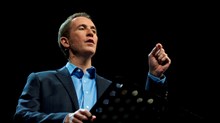If you're like me, numbers are maddening, particularly when it comes to the church. One reason is simple: how do you gauge how a church is doing in a quantitative, much less qualitative, way? Can you chart pastoral care, or community, or spirituality?"
One line you hear all the time is, "We're not into numbers." But the equally common response is, "We count people because people count." Numbers matter because they represent people, and people matter to God. No, they don't account for everything (a church isn't just about numbers), but they do account for something.
During my seminary years, all I heard about in terms of churches and numbers was "membership." As in, "they have 500 members," or "they have 5,000 members." The reason was simple: membership was the holy grail of church size.
Fuzzy Math
Then I became a pastor of a church. There I learned membership wasn't the metric I was led to believe. At least, not in our church. We had 500 or so members, but only about 175-200 were actually coming on any given Sunday. Many "on the rolls" had moved away, had stopped attending, or stopped breathing!
I kid you not. Dead members.
But heaven help you if you suggested removing them from membership. In those circles, in those days, that was akin to removing them from the rolls of heaven. So no wonder all those conference speakers talked about membership. It was the best-sounding metric they had.
Then I had a short stint working for the nation's largest Protestant denomination, the Southern Baptist Convention. Again, everyone talked about how many members a church had. Lead-ins to pastors speaking at conferences always talked about the size of their church in terms of how many members they had, many of which had thousands upon thousands of members.
Digging deeper, I found what was true of my first church was true of almost every other church I encountered. Actual attendance ran half or less of the membership numbers. The latest figures from the SBC show this phenomenon hasn't changed. At the end of 2013, overall membership in the Southern Baptist Convention was 15.7 million, while average weekly attendance was only 5.8 million.
So I guess the phenomenon has changed - it's gotten worse.
Here is the question: is the SBC nearly 16 million strong, or only 6 million strong?
When I planted Mecklenburg Community Church (Meck), I wanted a metric that told me how many people were not only calling Meck home, but making it home; how many people were not only in its orbit, but were actually involved. Membership mattered, to be sure, and one answer was to simply beef up membership and make it more reflective of the church and the biblical demands of church involvement. Yet membership still seemed to fall short of encompassing the church's overall size and reach. In fact, the churches that I respected most held to such a high standard of membership that they actually reversed the dynamic. Meaning, they had far more attenders than members. That seemed sound to me. If a church was healthy and membership mattered, you'd have a majority of card-carrying members present on most weekends, along with a solid dose of guests.
Not only that, membership is an increasingly hard sell to Millennials, not to mention the rising tide coming behind them known as "Generation Z." As much as you may value membership, there is an anti-membership bias among many in our culture. In previous generations, membership was the first step in church involvement. You found a church you liked, you joined, and then got involved. Today, involvement almost always precedes membership.
Beyond Attendance
So was the answer mere attendance?
I knew better than that.
I had already seen, from the earliest of years, how seasonal attendance can be. Easter is high. July 4th (for most) is low. You have a fall "run" from Labor Day to Thanksgiving, and then you start having lower days mixed in with higher days. You die between Christmas and New Years. Another run would then begin after the New Year, building to Easter, and then end by Memorial Day.
That's not all. Newer churches, which tend to be planted in new growth areas, drop in attendance on weekends whereas more traditional, established churches spike. Much of this is because people go "home" for the holidays, and in new growth areas, it's not that kind of "home" yet. So new churches have everyone "go" home, and more established churches have everyone "come" home.
But regardless of what kind of church it is, few people attend every weekend. A very committed person might only attend 40 weeks a year. This means that most churches are "bigger" than their average attendance.
Of course, the more substantive issue with mere attendance is that it says very little about impact and influence. So you have a crowd? The real issue is whether people are coming to Christ from that crowd, and growing in that relationship.
So if membership doesn't give a sense of a church's true size, and neither does weekend attendance, what does?
A New Metric
At Meck, we stumbled on to something that was new to us (but I have no doubt others have thought of it as well), which employs an entirely different metric: "active attenders." This metric does not replace membership, but it does complement it.
How we define an active attender is simple. If we can point to someone being "active" through such activities as attending, giving, or serving, then they go into the "active attender" category. If we can't point to them being active within a six-month period, they come out of that category. So our number of active attenders is updated monthly, with many being added, and many being subtracted. If they are removed from the active attender category, we keep them in our data base, but that is all.
To us this metric seems to be the most valuable for gauging a church's overall size, and even its health. Here are the people we can point to, by name, who are currently involved. We know who they are, how they are connecting, and that they are truly part of our community. We have many more than these attending because to become "active" you have to engage in some recognizable way. But we're most interested in tracking people who are truly involved and participating.
We maintain membership, but it is by design, a much smaller number. To be a member means moving beyond the active attender status and making a specific commitment to the church through membership. You have to take a class, and agree to a doctrinal statement and set of core values through a simple but important covenant. You also have to be baptized as a believer. Only members are allowed to be "platformed," allowed to sing or speak, and to be involved in leadership positions. Only members can participate in various business matters, such as voting on the annual budget.
If a member were to fall out of "active attender" status, they would also be removed from membership. That sounds a bit harsh, but there's a deeply caring pastoral process. We believe membership must be active. As of the time of this writing, we have well over 1,000 adult members (not counting their families). They are like our church's Navy SEALs or Army Rangers. They are an elite and important group. But while they are the core of the church and are, themselves, active attenders, they do not constitute all of the church.
Right now, Meck has over 10,000 active attenders of all ages. Our 2020 Vision is to be a church of 20,000 active attenders with ministry in 20 countries by the year 2020. As mentioned, membership is far lower than this, but for us, that is how it should be. We always want more people coming, more people active, than are members. To us, that is a sign that we are continually reaching out. In fact, the other metric that is critical to our thinking is the number of people being moved into active attender status and then membership who were previously unchurched. For us, over 70 percent of our total membership growth comes from that category.
We track other metrics, to be sure: baptisms, overall data base numbers, seasonal attendance patterns, small group participation, institute participation (our discipleship program), and more. But if someone asked me the typical "How big are you?" question, we'd fall to active attenders.
Because that is how big we are.
Do we have over 10,000 every weekend across all of our campuses? Not on July 4th weekend. But not on Easter, either, when we've had to hold services at 20,000 seat outdoor amphitheaters. But that's the point. We don't look to either date for "who we are." We look to a larger span of time (six-months), and much more than weekend attendance. Meck is a church of over 10,000 active attenders. That is our metric. It's who we are.
James Emery White is pastor of Mecklenburg Community Church, Charlotte, North Carolina. His most recent is The Rise of the Nones: Understanding and Reaching the Religiously Unaffiliated (Baker).
Copyright © 2014 by the author or Christianity Today/Leadership Journal.
Click here for reprint information on Leadership Journal.

Support Our Work
Subscribe to CT for less than $4.25/month


























